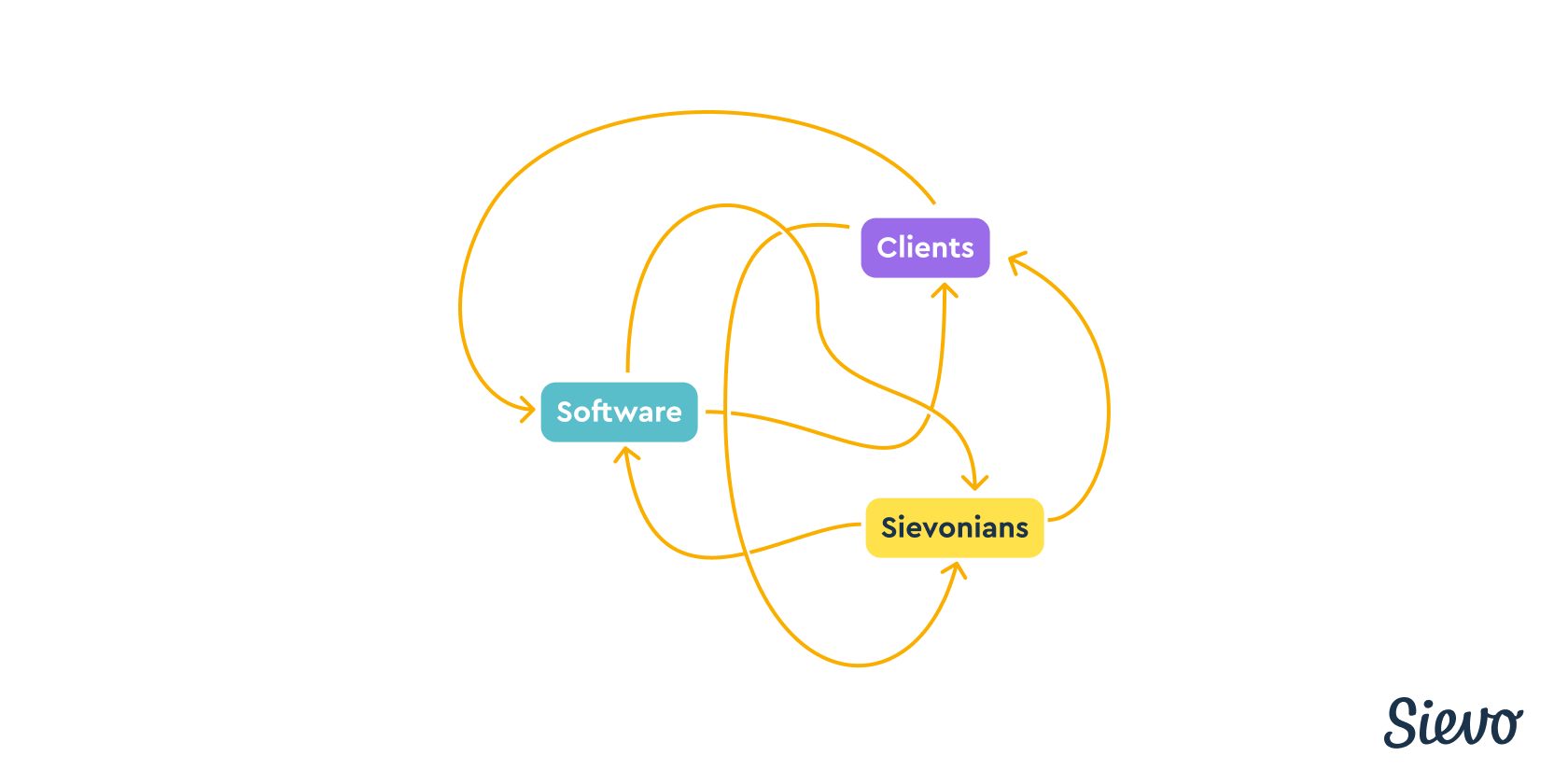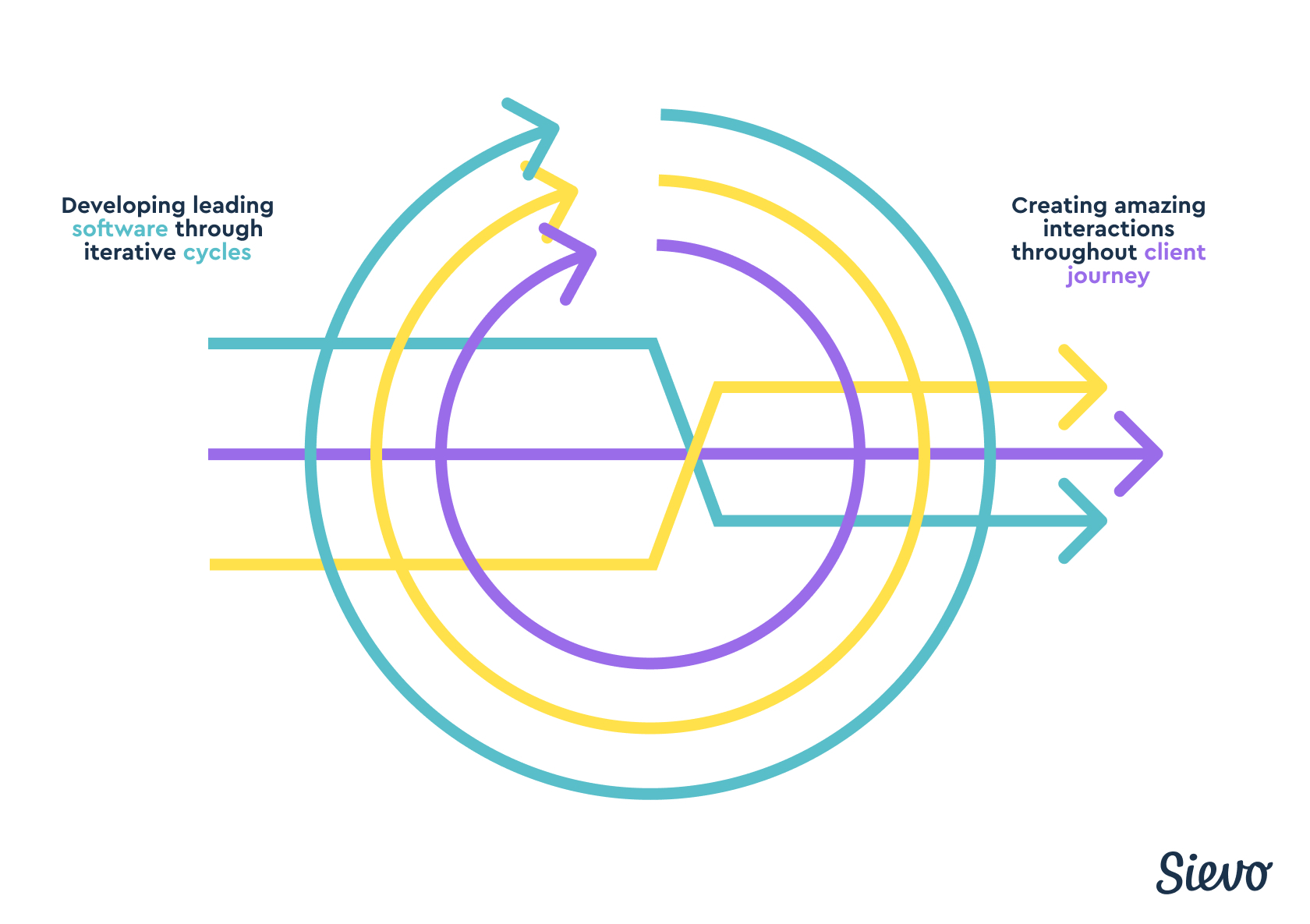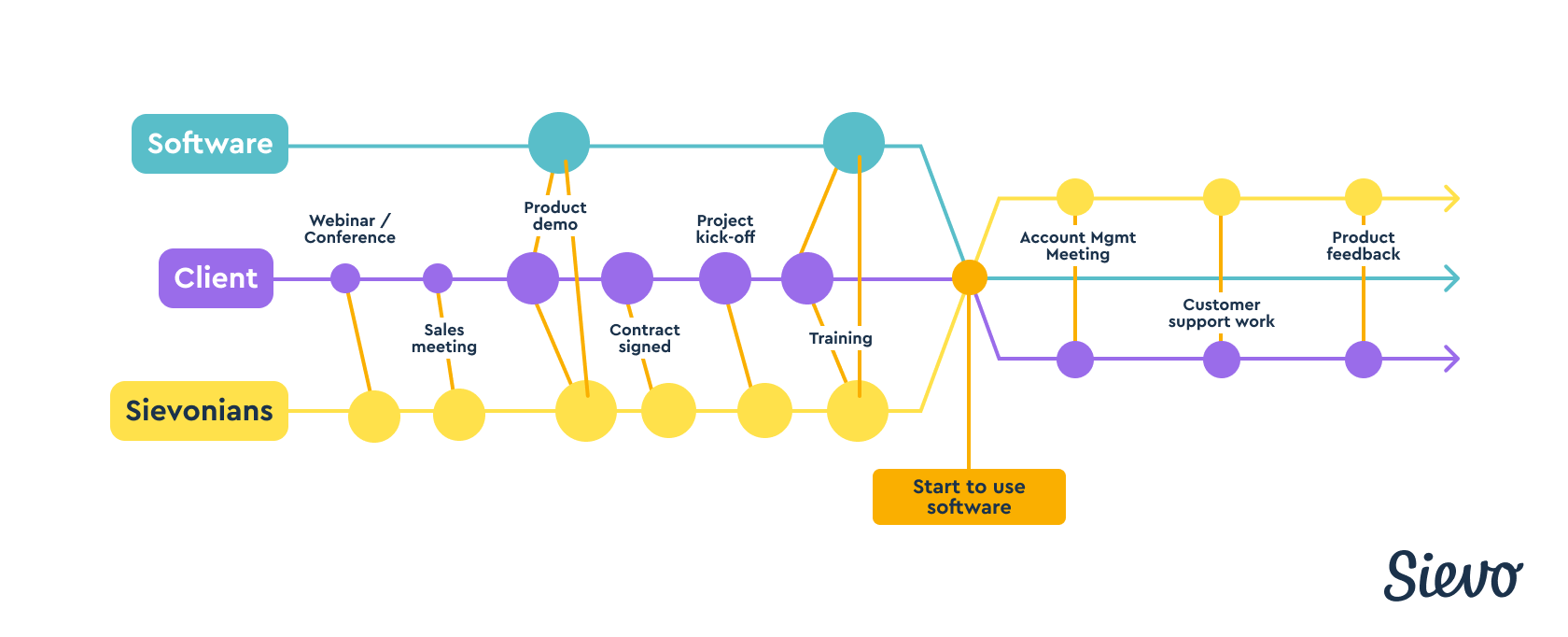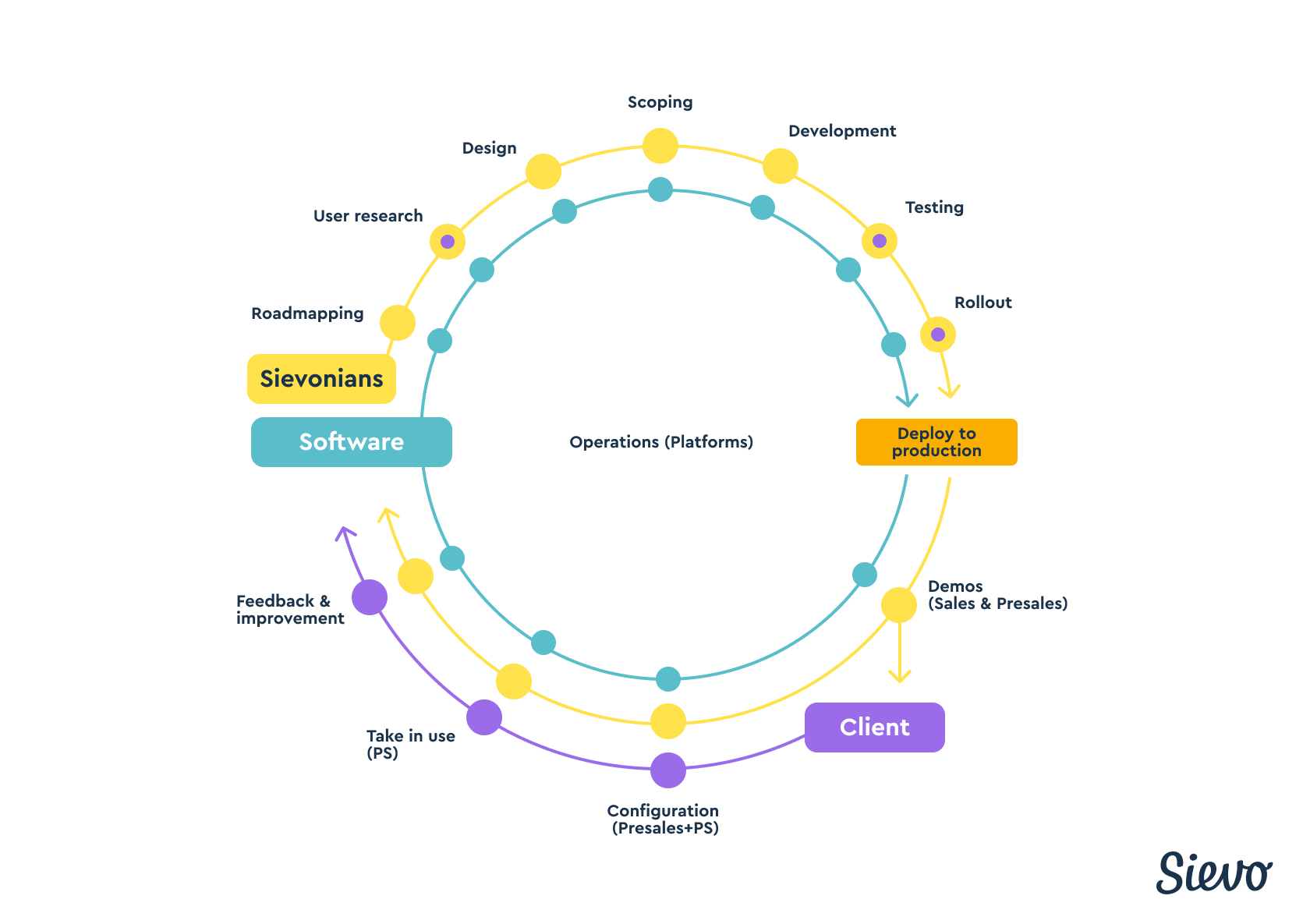
Sievo Culture
Organization chart is dead: how to organize your company for growth
.jpg?width=150&name=admin-ajax%20(1).jpg)
Anna Tapiovaara • Oct 15, 2021
We often have the pleasure to introduce Sievo to people who are either considering joining Sievo, or have just joined. In this context, we want to both to excite and educate. To do this, we’ve felt, we need to provide a number of different perspectives. For example, we go through our values to anchor what we believe in and share our grand ambitions to set the bar correctly. We share an overview of the customers we’ve got the privilege to serve to create awe and excitement. We explain business problems that we solve and demonstrate our product on how we exactly do that. This part has always felt easy and natural.
But we also want to explain how we operate as a company. And, the easiest way out has been showing our organizational chart. And we’ve always hated that – while speaking, we’ve always felt that we’re doing injustice to reality, highlighting wrong things and … also making new Sievonians very bored. We’ve yet to hear of a human being that has shown genuine interest in an organizational chart. In summary - we’ve felt that showing an organizational chart is the worst way of explaining how a knowledge intensive organization works.
Reflecting on this, we came to realize that organizational charts are even worse than we thought. It is just the wrong way to describe how a company like Sievo operates for many reasons. Even if we would try to imagine a more harmful way to describe organizations than organizational chart, we’re not sure if we could imagine one.
4 reasons why organization chart is a dangerous way to describe how a company operates:
Organizational charts highlight divisions between functions, not collaboration.
You need to organize a company of our size somehow. By defining organizational boundaries, you de-facto define communication patterns; more communication will take place within organizational units than across them. This is fine – all ways to organize will be harmful in some ways, you just need to pick the least harmful one, and strive to compensate for the harm done. For us the least harmful way has been our organizing model of Global Funcions, Local Teams. However, as there’s more organic collaboration within functions than across, highlighting this split in communications (by creating white space between function boxes), runs the risk of deepening those divides, rather than compensating for them. Also, a traditional organizational chart illustration suggests that there is not communication between the functions (lines get together only at CEO level). Companies get organizational silos partly since they describe organizations as one. Any helpful illustration of how company operates should highlight interactions between functions.
Organizational charts represent a self-centric world view, and misses the customer.
An organizational chart is limited to your own organization. It completely misses the fact that company is in the business to serve our customers. If the aim is to describe how we operate, it’s impossible to do that without having the customer as a part of the description.
Organizational charts communicate dangerous illusions of order and stability.
Yes, it is possible to top-align those organizational boxes in PowerPoint. However, we all know that the reality of knowledge intensive organizations is not that of nicely organized boxes, but one of constant dense interaction and continuous adaption, as it should be. A good metaphor for organization should reflect the complex reality we live in and provide room for constant evolution.
Organizational charts are hierarchy focused.
An organizational chart will inevitably have CEO in its own box, and CxOs/VPs of different organizational units in their own respective boxes. This sends a message of hierarchy, which is the exact opposite of what needs to be highlighted in a modern organization. A healthy metaphor for organization avoids focus on hierarchy.
Confronted with the above challenges, wejoined forces to create a better visual explanation of “How Sievo operates”. We came down to three levels of abstraction, and three different images.
- What is important for us --> Interactions between Clients, Sievonians and Software
- How our work is arranged --> Two symbiotic forms of life
- How work concretely takes place --> Client journey and software cycle
Interactions between Clients, Sievonians and Software
First of all, we felt that any description of “How Sievo operates” needs to highlight what’s important for us. And it is three things:
- Clients that we have privilege to serve, and who pay our salaries.
- Sievonians whose collective creativity, energy and effort is the only way we can create meaningful impact
- As a SaaS-company, lot of value we provide for our customers is software-intermediated. Unless we have a winning product, we cannot compete in SaaS-business.
But, we also realize that it is interactions between the three above components that create value. Value is created in interactions. If we have a great product that is not used by customers – it’s waste. Regardless of how great the time is that we spend together among Sievonians, unless we create value for customers, the party will be short. And, we believe, clients can drive value best by interacting with Sievo’s software and with Sievonians.
With the above reflections, the first level of abstraction of “How Sievo operates” is shown below. 
Describe two symbiotic forms of life
As next step, we wanted to describe that most work at Sievo organizes itself around two forms of life. Note that instead of describing these as processes, which would send the signal of orderly pre-designed steps, we call these forms of life.
We believe that forms of life is a good description for many reasons:
- Describes organization as one where constant evolution and growth takes place
- Highlights organic connection between entities
- Sends the signal that both forms of life need to be constantly nurtured
- Provides room for all Sievonians play a role in developing these forms of life further
For us, these two forms of life are:
- Client journey; and
- Software cycles.
At this level of abstraction, we want to make the point that:
- There are two distinct forms of life at Sievo
These forms of life live in symbiotic relationship. There’s no one without the other. Our success as Enterprise SaaS-company depends on that we get both of them, and interactions between them, correct.

Client journey and software cycles
Discussion this far has been relatively abstract. As we want to provide new Sievonians a tangible understanding of the overall operations, we need to get more concrete. Specificity is the soul of narrative. Therefore we’ve described both forms of life in bit more detail.
Client journey
Client journey describes all work that revolves around a specific client. It starts from sales phase, where we convince clients that Sievo is the right solution for them, continues with implementation services, and then on to serving the client until eternity. Lot of interactions are between a Sievonian and Client directly, but especially during latter phases of journey, lot of interactions are intermediated by software as well. Many Sievonians will recognize their role in the client journey. But, by showing this as a client journey, we also send the message that the client (and not our functional boxes) is important, and that there’s colleagues’ contribution before and after you step in. Also, by design, we did not overlay our different functions on the journey. The journey is more important than any function.
The point of the illustration below is not to be an exhaustive one. It’s to provide an idea of concrete interactions that happen throughout the journey, hopefully helping a new Sievonian to grasp the overall journey. For a new Sievonian, it is easier to imagine what “Product demo” or “Contract signed” events mean than generic “implementation project”. Note also that whilst this is a client journey centric view of the world, it encompasses lot of software related components – it’s a symbiotic relationship.

Software cycles
Software cycles describes all work that revolves around a specific product. This is a cycle to represent the never-ending quest to create a leading product through frequent iterations. This is a product-centric view, where both Sievonians and Customer play a role in enabling value (design & development) and capturing value (use of software).
Again, the picture below is not designed to be an exhaustive one. Instead, it is designed to provide concrete examples of interactions that take place, so that people can relate to what’s going on. Also it, by design, shows both the design&develop and capture value phases of the software lifecycle. And, whilst this is a software/product centric view, it includes client/customer at multiple different steps. 
This blog is written as part of Sievo Culture blog series by Sammeli Sammalkorpi (CEO and founder), Anna Tapiovaara (VP People & IT) and Luca Rossi (Service Designer). We are all about creating transparent and data-driven world, while being awesome. If you like what you read and are looking for the next ride in your career playground, see our open positions at: https://sievo.com/careers

Open Positions
Welcome to explore our open job opportunities around the world
- Position
- Location
- Apply Before

